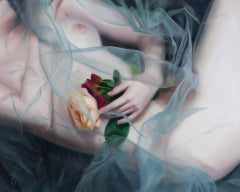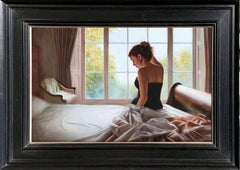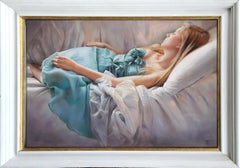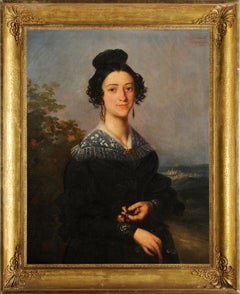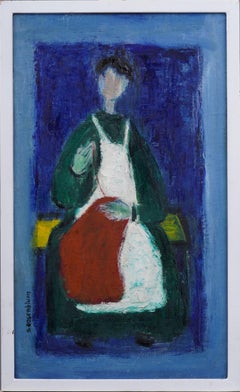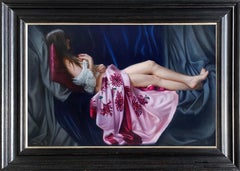Tina Spratt Art
to
4
1
3
4
1
1
3
1
Overall Height
to
Overall Width
to
2
4
4
2
1
1
1
1
2
3
5
6,998
3,356
2,513
1,213
5
5
4
3
1
Artist: Tina Spratt
The Call
By Tina Spratt
Located in Belgravia, London, London
Oil on canvas
Canvas size: 16 x 28 inches
Framed size: 21 x 33 inches
Signed lower left
Category
20th Century Tina Spratt Art
Materials
Canvas, Oil
Stay
By Tina Spratt
Located in Belgravia, London, London
Oil on canvas
Canvas size: 16 x 24 inches
Framed size: 22.5 x 30.25 inches
Signed lower left
Category
20th Century Tina Spratt Art
Materials
Canvas, Oil
Whisper
By Tina Spratt
Located in Denver, CO
Whisper, 2018
Category
21st Century and Contemporary Tina Spratt Art
Materials
Panel, Oil
Stay
By Tina Spratt
Located in Belgravia, London, London
Oil on linen
Linen size: 16 x 24 inches
Framed size: 22 x 30.5 inches
Monogrammed lower left
Category
21st Century and Contemporary Contemporary Tina Spratt Art
Materials
Linen, Oil
Sweet Dreams
By Tina Spratt
Located in Belgravia, London, London
Oil on canvas
Canvas size: 19 x 27 inches
Framed size: 24 x 32 inches
Monogrammed lower right
Category
21st Century and Contemporary Contemporary Tina Spratt Art
Materials
Canvas, Oil
Related Items
Portrait of a young girl
Located in BELEYMAS, FR
Louis Joseph César DUCORNET
(Lille 1806 – Paris 1856)
Portrait of a young girl
Oil on canvas
H. 92 cm; L. 73 cm
Signed upper left, dated 1837
When he came into the world in Lille in...
Category
1830s French School Tina Spratt Art
Materials
Canvas, Oil
Vintage Signed Exhibited American Female Modernist Woman Sewing Framed Portrait
Located in Buffalo, NY
Nicely painted mid century modernist interior portrait oil painting by Sadie Skoletsky Rosenblum 1899-1987. Great color and composition. Framed.
Category
1940s Modern Tina Spratt Art
Materials
Canvas, Oil
Antique American Impressionist Opera Scene Signed Elegant Oil Painting
Located in Buffalo, NY
Nicely painted American impressionist oil painting by Richard W. Baldwin (1920 - 2012). Oil on canvas. Framed. Signed.
Category
1930s Impressionist Tina Spratt Art
Materials
Canvas, Oil
Female Cornish artist, Walter Sickert pupil, Cubist portrait of man in interior
Located in Harkstead, GB
A really stylish portrait of a young man relaxing in an interior, painted in a unique, almost cubist style and wonderful texture to the brushwork.
Garlick Barnes ( 1891-1987)
A man reading in an interior
Signed
Oil on canvas
24 x 20 inches without frame
29 x 24½ inches with frame
Barnes raised four children before turning her full attention to art. She studied at the Sidney Cooper School of Art, Canterbury, and at Heatherley's. In 1936 Garlick became a pupil of Walter Richard SICKERT...
Category
20th Century Modern Tina Spratt Art
Materials
Canvas, Oil
H 24 in W 20 in D 1.5 in
Portrait Gentleman Black Coat Orange Sash, Dutch Old Master, Oil on Panel c.1650
By Bartholomeus van der Helst
Located in London, GB
This exquisite portrait of a gentleman depicted in a sumptuous black coat edged with silver and slashed sleeves is an excellent example of the type of portrait fashionable in England and the Low Countries during the 17th century. The confident pose, striking orange sash - the colour of the house of Orange Nassau - and the leather gorget imbue the sitter with a sense of masculinity and power. The profusely decorated costume is of the highest quality and de rigueur of an elite class - the artist has carefully cultivated this portrait to emphasise the sitter’s wealth and standing in the society that he belonged to. The casual pose, with one arm resting on a hip, is much less formal than earlier decades, and it speaks of ‘sprezzatura’ – one’s appearance should not appear laborious, but instead, effortless.
The oil on cradled panel portrait can be dated to circa 1650 based on the hairstyle and the attire - small falling collar, short doublet (doublets reduced in size to just below the ribcage in the late 1650’s), and the type of slashed sleeves with the sleeve seams left open to reveal the white fabric.
The demand for portraits in the Netherlands was great in the 17th century. Bartholemeus van der Helst was considered to be one of the leading portrait painters of the Dutch Golden Age surpassing even Rembrandt as the most sought-after portraitist in Harlaam. The Dutch Golden Age, roughly spanning the 17th century, was a period when Dutch trade, science, military, and art were among the most acclaimed in the world. Dutch explorers charted new territory and settled abroad. Trade by the Dutch East-India Company thrived, and war heroes from the naval battles were decorated and became national heroes. During this time, The Dutch Old Masters began to prevail in the art world, creating a depth of realistic portraits of people and life in the area that has hardly been surpassed. The Golden Age painters depicted the scenes that their discerning new middle-class patrons wanted to see. This new wealth from merchant activities and exploration combined with a lack of church patronage, shifted art subjects away from biblical genres. Still life’s of items of everyday objects, landscapes, and seascapes reflecting the naval and trade power that the Republic enjoyed were popular. The new wealthy class were keen to have their portraits commissioned and many artists worked in this lucrative field. Such was the popularity of art that everyone had a painting, even the humble butcher, and hundreds of thousands of paintings were produced.
By tradition the sitter is Maarten Tromp (1598-1653) who was an Admiral in the Dutch Navy (the reverse of the portrait contains an old handwritten inscription “van Tromp”). Certainly, the distinctive orange sash is similar to those worn by officers of the Dutch army in the Netherlands who served under the Princes of Orange and the House of Nassau. However, it should be noted that the physiognomy differs from other images of Tromp.
Tromp was the oldest son of Harpert Maertensz, a naval officer and captain. He joined the Dutch navy as a lieutenant in July 1622 and was later promoted from captain to Lieutenant-Admiral of Holland and West Frisia in 1637. In 1639, during the Dutch struggle for independence from Spain, Tromp defeated a large Spanish fleet bound for Flanders at the Battle of the Downs, which marked an enormous change - the end of Spanish naval power. He was killed in action during the First Anglo-Dutch War in 1653 where he commanded the Dutch fleet in the battle of Scheveningen.
Gloves were an absolutely vital accessory and the elaborate pair in this portrait are embellished with threads of silk and precious metals and salmon-coloured lining. He wears only one glove and holds the other, providing an opportunity to better display the cuffs and detail on his right wrist and forearm. The gloves are probably made from the most prized leather which came from Spain, in particular from Cordova. Cordovan leather was tanned with a special vegetal process that left it both highly impermeable and divinely soft. King Charles I, posed in a rather relaxed manner for Daniel Mytens’s portrait in 1631, is wearing gloves and boots in matching Cordovan leather. The hide is thick, but you can see just how supple it is from the way the gauntlet dimples and the long boot legs fold over themselves, rippling and wrinkling at the ankles.
Apart from keeping hands warm the use of gloves during the 15th through the 19th centuries were full of symbolism and they were worn regardless of the season. They kept the skin unblemished - soft, smooth hands were considered highly attractive. This combination of necessity and proximity to bare skin made gloves a deeply personal gift and they took on a strong symbolic significance and were regarded as emblematic of fidelity and loyalty for hundreds of years. Such was the importance of their symbolism was that some gloves were never intended to be worn at all. Their luxury made them ideal gifts at court, and so in the 15th and 16th centuries, ambassadors often presented them as symbols of loyalty.
Until the mid-19th century, it was customary to give gloves as tokens to guests at weddings and to mourners at funerals. Gentleman often gifted their bride-to-be with a pair of gloves (the obligatory gift) and were handed over at the betrothal and put on display before the wedding took place. It was probably their direct contact with the skin that led to the eroticism of gloves. Not only were pairs often exchanged between lovers, but from the 16th to the 18th centuries, it was common practice to remove one glove and give it as a gift to a favourite. The idea of the item being presented still warm from the wearer’s hand is certainly suggestive. Following the death of King George IV, his executors purportedly found over a thousand mismatched ladies’ gloves among his possessions.
The sentiment of a 17th-century poem reveals the popularity of the practice: “Come to our wedding to requite your loves / Shew us your hands and we’ll fit you with gloves.” Such generosity might be pricey for the hosts, but gloves of varying quality could be offered depending on the status of the recipient. Pairs made with the finest Spanish leather might be reserved for immediate family, while coarse sheep’s leather could be distributed among the servants and tradesmen. The apportioning of quality according to class provided a very clear message of the gloves’ intended use. For refined guests, they were decoration; for the lower classes, they were functional.
Bartholomeus van der Helst...
Category
17th Century Old Masters Tina Spratt Art
Materials
Oil, Wood Panel
H 38.59 in W 31.89 in D 2.76 in
Venice at Dusk
By Lucien Whiting Powell
Located in Milford, NH
A fine Italian coastal oil painting with boats titled “Venice at Dusk” by American artist Lucien Whiting Powell (1846-1930). Powell was born in Levinworth Manor, Virginia, joined the 11th Virginia Cavalry at 17 and fought in the Civil War, pursuing his art career after the war, studying with Thomas Moran in Philadelphia and at the Pennsylvania Academy of the Fine Arts. He is also said to have studied in New York City, probably with Moran who moved there in 1872. He was an admirer of British artist J...
Category
Early 20th Century American Impressionist Tina Spratt Art
Materials
Canvas, Oil, Panel
Herman Jensen, A Musician, Oil Painting
Located in Cheltenham, GB
This enchanting early 20th-century oil painting by Danish artist Herman Jensen (1893-1941) depicts a seated woman playing the banjo before a window.
Scenes with musicians are most f...
Category
1920s Impressionist Tina Spratt Art
Materials
Oil, Canvas
Sketch of a dandy portrait
Located in BELEYMAS, FR
French school circa 1840
Sketch of a dandy portrait
Oil on canvas mounted on cardboard
H. 21 cm; L. 20.5 cm
Category
1830s French School Tina Spratt Art
Materials
Canvas, Oil
The Girl with the Green Ribbon - Contemplative Female Figure, Oil on Panel
By Tina Figarelli
Located in Chicago, IL
Tina Figarelli is a classically trained artist whose favorite subject matter in her artwork is ideas with a strong narrative. Tina leaves the viewer hints about the story in the piec...
Category
2010s Contemporary Tina Spratt Art
Materials
Oil, Panel
Baroque Portrait of a gentleman 18th century Italian master by Domenico Parodi
By Domenico Parodi (Genoa, 1672 - 1742)
Located in Stockholm, SE
We are grateful to Prof. Daniele Sanguineti for suggesting the attribution to Domenico Parodi (1672 - 1742). He dates the painting into the period between 1730 and 1740. Domenico Par...
Category
1730s Realist Tina Spratt Art
Materials
Canvas, Oil
Free Shipping
H 37.4 in W 28.34 in
Portrait of Gentleman, Thomas Bruce, Earl of Elgin c.1638 Manor House Provenance
Located in London, GB
Titan Fine Art present this picture which formed part of a historic collection of an English aristocratic family, Lord and Lady Sandys at their magnificent baroque and Regency Grade-I listed family home, Ombersley Court. The house was among the most fascinating survivals of its kind in this country. The atmospheric interiors were distinguished above all for the works of art associated with two key moments in national history and, more specifically, to the roles of Colonel the Hon. John Russell in the Civil War and the reign of King Charles II and of Lord Arthur Hill, later 2nd Baron Sandys, in the Peninsular War. The collection was acquired or commissioned over five centuries and remained at Ombersley Court until its recent sale, the first in 294 years. This painting hung in The Great Hall (see photo).
This charming portrait is an example of the type of small-scale panel portraits, often of splendid beauties of the time, that became fashionable from about the first quarter of the seventeenth century. The sitter has been depicted wearing a low-cut silk dress with the wide billowing sleeves typical of the late 1630’s. The simplicity of the ensemble is reinforced by the absence of lace on either the collar or cuffs. At this time gone are the complicated layers of fabrics, and now replaced with understated elegance of plain silk (satin and taffeta were most popular), with only a couple of focal points as accessories. There is an abundance of the accessory par excellence – pearls, and they are worn as a necklace, on her attire, and as earrings; the pear-shaped earrings are called ‘unions excellence’ reflecting the difficulty of finding perfectly matched pearls of such large size. They could range up to 20 millimetres in diameter. There is a splendid display of gold, diamond and pearl jewellery which is an obvious sign of her wealth.
The portrait is thought to represent Thomas Bruce (1596-1654), Earl of Elgin. The physiognomy and features in our portrait strongly correlate to a portrait of the Earl, by Cornelius Johnson (1593-1661), painted circa 1638, and is held at Kenwood House, London. Another painting from Ombersley Court, also with Titan Fine Art, is contemporaneous to ours and is thought to represent the Earl’s wife, Diana Cecil, 1st Countess of Elgin (c.1603-1654) - it appears to have derived from Cornelius Johnson’s depiction of the Countess circa 1638, also at Kenwood House. During the 1630’s Johnson painted a number of portraits, obviously influenced by Van Dyke. Here, Theodore Russel, who worked in the studios of both Van Dyle and Johnson, and later specialised in small scale reproductions of his master’s works, modelled the head, with the striking large dark eyes, on Cornelius Johnson, and the attire on Anthony van Dyke. There are also other portraits by Johnson of the sitter with very similar facial features to that of the sitter in ours. Theodore Russel and Cornelius Johnson also had a family connection as it is thought that Russel’s step-mother was a sister of Johnson.
Thomas Bruce, 1st Earl of Elgin, was a prominent Scottish nobleman who held titles such as the 3rd Lord Bruce of Kinloss. He resided at Houghton House in Bedfordshire and played a significant role in the political and social landscape of his time. His legacy as an Earl and Lord continues to be remembered in history.
Thomas Bruce, born in Edinburgh in 1599, inherited the Scottish peerage title as the 3rd Lord Bruce of Kinloss at the age of 13 following his brother's untimely death in a duel. The family's estates, including Whorlton Castle and manor, were granted by King James I of England to Thomas's father, with the wardship of Thomas and the estates entrusted to his mother until he reached the age of 21. He maintained a strong connection with King Charles I's court during the Personal Rule, receiving titles of honour and prestigious roles throughout the years.
Thomas Bruce was married twice in his lifetime. His first marriage was to Anne Chichester in 1622. Ann died in 1627, the day after giving birth to their only child, Robert Bruce, who later became the 1st Earl of Ailesbury. On 12 November 1629, Thomas Bruce married Lady Diana Cecil, the daughter of William Cecil and widow of Henry de Vere. The marriage was childless, but Diana brought significant estates with her. Thomas Bruce died on 21 December 1663 at the age of 64.
This oil on panel portrait has been well cared for over its life, which spans almost four centuries. Having recently undergone a treatment to remove an obscuring discoloured varnish, it can be fully appreciated, and attributed to Theodore Russel.
Once owned by Evesham Abbey, the manor of Ombersley was acquired by the Sandys family in the early 1600s, when Sir Samuel Sandys, the eldest son of Edwin Sandys, Bishop of Worcester and later Archbishop of York, took a lease on the manor, before receiving an outright grant in 1614. The present house, Ombersley Court, dates from the time of Samuel, 1st Lord Sandys, between 1723 and 1730. The house itself is a fine example of an English Georgian country house set in rolling countryside and surrounded by Wellingtonias, planted to commemorate the Battle of Waterloo by Arthur Hill, 2nd Baron Sandys, who played a distinguished part in the battle and was one of the Duke of Wellington’s aides de camp. The Duke also stayed in the house and in the Great Hall, was the Waterloo banner which was brought to the house by Sir Arthur Hill, aide-de-camp to the Duke of Wellington, who succeeded his mother, the Marchioness of Downshire as 2nd Lord Sandys. Further Waterloo memorabilia are kettle drums from battle. The family had a strong tradition of military and political service, dating back to the 17th century, and this was also reflected in the fine collection of portraits and paintings in the house. In short, Ombersley represented a vital aspect of British history. The house and more especially the collection were of the greatest historical importance. Houses that have remained in the possession of the same family for as many as three centuries have become increasingly rare.
Through this portrait, collectors have a chance to acquire a piece of British history and an evocative vestige of a glittering way of life, which is now gone.
Presented in a fine period frame.
Theodore Russell, or Roussel, was born in London in 1614. His father came from Bruges to England and was the Royal Stuart jeweller. His apprenticeship was spent in the studio of his uncle, Cornelius Johnson, with whom he lived for about nine years. Sometime after 1632, he is said to have worked as an assistance to Van Dyck. He executed numerous copies of portraits by his famous master and other notable painters, also painting original works. He is particularly remembered for his portraits of Charles II at Woburn Abbey and James II at the Palace of Holyrood. His son, Antony Russel (c.1663–1743) was also a portrait-painter and is said to have studied under John Riley. Several of his copies were in the Royal Collections, and among the nobility.
Provenance
Richard Hill...
Category
17th Century Old Masters Tina Spratt Art
Materials
Oil, Wood Panel
H 18.9 in W 16.15 in D 1.58 in
Black Beauty
Located in Ibadan, Oyo
Painting
Ships in a well-protected tube from Nigeria
This work is unique, this is not a print or other type of copy.
Signed on the front side and accompanied by a Certificate of Auth...
Category
21st Century and Contemporary Contemporary Tina Spratt Art
Materials
Canvas, Oil
Previously Available Items
Serene
By Tina Spratt
Located in Belgravia, London, London
Oil on linen
Linen size: 18 x 14 inches
Framed size: 24.25 x 20.25 inches
Monogrammed lower right
Category
21st Century and Contemporary Contemporary Tina Spratt Art
Materials
Linen, Oil
One Moment
By Tina Spratt
Located in Belgravia, London, London
Oil on linen
Linen size: 16 x 24 inches
Framed size: 21 x 28.75 inches
Monogrammed lower right
Category
21st Century and Contemporary Contemporary Tina Spratt Art
Materials
Linen, Oil
Tina Spratt art for sale on 1stDibs.
Find a wide variety of authentic Tina Spratt art available for sale on 1stDibs. You can also browse by medium to find art by Tina Spratt in oil paint, paint, fabric and more. Much of the original work by this artist or collective was created during the 21st century and contemporary and is mostly associated with the contemporary style. Not every interior allows for large Tina Spratt art, so small editions measuring 8 inches across are available. Customers who are interested in this artist might also find the work of Adolfo Ramon, Charlie Mackesy, and Kate Brinkworth. Tina Spratt art prices can differ depending upon medium, time period and other attributes. On 1stDibs, the price for these items starts at $1,150 and tops out at $18,520, while the average work can sell for $9,322.


